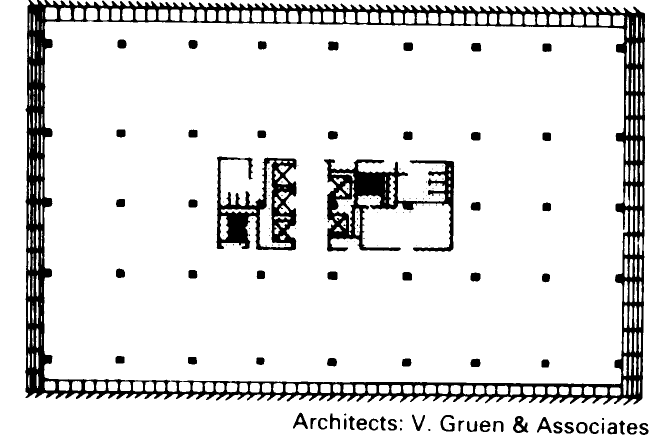Office Buildings. Organisation of Plan. High-rise Buildings
The placement of general expansion joints depends on the type of structure, foundations, ground conditions, etc. They are usually between 30 and 60m apart. Joints are generally required to accommodate movement safely, e.g. structural movement, or thermal expansion and contraction.

Rental offices; 93% rentable floor area. Public circulation vertically. Asymmetrical design allows small rooms and large open offices

Steel skeleton acts as rigid loadbearing structure; no need for bracing with wall panels. Vertical fins, east and west; horizontal sun shades, south

Typical floor-plan for open offices; lavatories separated. External columns allow furniture to be positioned anywhere. 17.50 m free span
The simplest design uses reinforced concrete to erect paired columns that are covered to protect against weather.
Cantilevered floors and expansion joints between the two cantilevers are subject to the greatest stress.
Complex designs, e.g. with connected buildings and parapets, usually create enormous stresses.
High-rise buildings. The first high-rise buildings were office blocks. Lower floors usually contained shops and stores with sales areas throughout and no atria. Office areas were located above, and were often set off by a different scale and choice of materials. Vertical circulation components, lifts, stairs and service rooms in a central location had only artificial ventilation and lighting. New possibilities were provided by stepped buildings with stairway and lift towers situated immediately to one side.
High-rise buildings are intended for continuous human occupation, and have a floor on the top storey on at least one side of the building that is more than 22m above ground level. Window sills must be at a height of at least 0.90m above floor level and be fire resistant. Window surfaces that cannot safely be cleaned from inside the building must be cleaned by experts, using exterior equipment.
High-rise buildings should be divided into fire compartments that are 30m long and enclosed by fire-resistant walls. Escape routes from each room on each storey must be provided via at least two independent staircases. Alternative escape routes within limited travel distance must be accessible from the fire to a protected zone. One stairway must have external windows on each floor. In high-rise buildings, some staircases should be constructed as fire-fighting staircases with smoke outlets, vents and fire-resistant, self-closing doors. The effective width of stairways and landings depends on the function of the building, but must be at least 1.25m. Emergency stairs must have an effective width of at least 0.80m.

Single-range building that is economical because of 10.0 m deep rooms; central vertical circulation connects the two parts of the building
A frame construction of steel or reinforced concrete is the standard structure for high-rise buildings. The need for flexible spaces with large spans is making masonry construction obsolete. However, the size of span depends on material and design. A solid reinforced concrete floor can have a span of 2.5-5.5m, and a ribbed floor 5.0-7.5m, both with a maximum 12.5m between main beams. The effective span of pre-stressed concrete is 25.0 m, but only with 0.75m structural depth. The exterior wall should be a curtain wall in front of set-back external columns. In both steel construction and assembly units, steel main and secondary beam systems make assembly easier but shorten the possible spans. A mixed design with a steel frame and concrete floors is often used.
Date added: 2023-01-05; views: 703;
